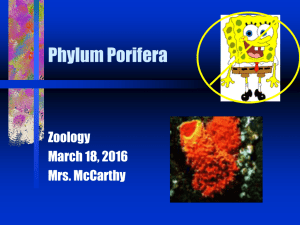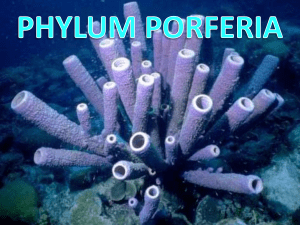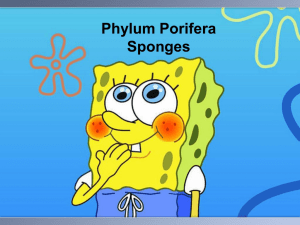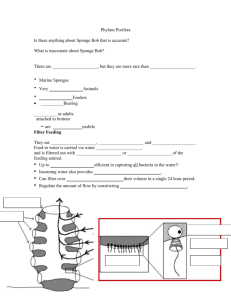PowerPoint 5: Porifera
advertisement
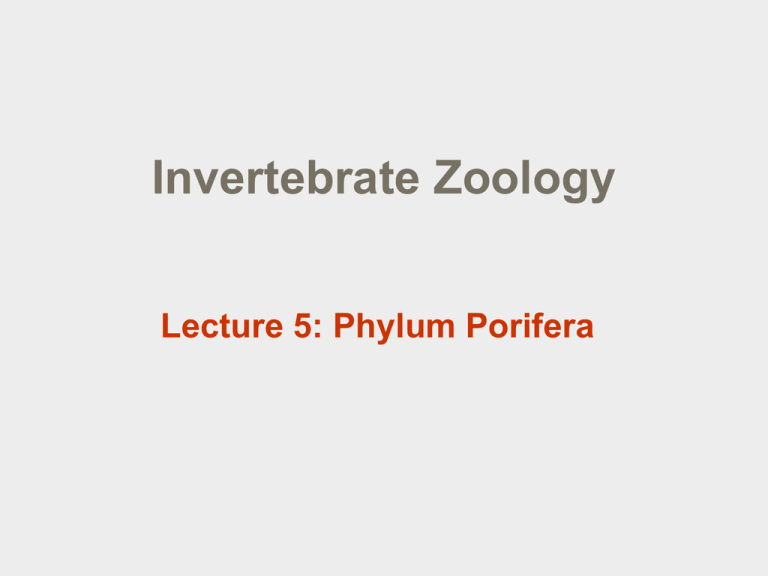
Invertebrate Zoology Lecture 5: Phylum Porifera Lecture outline Phylum Porifera Overview Body structure and the aquiferous “system” Nutrition, excretion and gas exchange Activity and Sensitivity Reproduction Reaggregation Protection Sponges as habitat Sponges and Humans Overview Considered to be plants until 1765. Diversity: three major groups 1. Calcarea: Calcareous sponges Calcium carbonate (calcite) spicules Primarily shallow water and tropical (some exceptions) Photo: www.meer.org Overview Diversity: three major groups 2. Hexactinellida: Glass Sponges Siliceous, 6-rayed spicules Marine, primarily deep water Overview Diversity: three major groups 3. Demospongiae: Demosponges Siliceous spicules (never 6-rayed) and/or spongin for support Overview Simplest multicellular animals Considered "multicellular" rather than colonial because there are different cell types. Key cell type, the choanocyte, resembles a cells of a choanoflagellate (Protista) Choanoflagellate Overview Key characteristics (see Box 6A) Metazoa No true tissues or body systems of any type Not much, if any. coordination among cells Layers lack basement membrane Adults are asymmetrical or superficially radially symmetrical Totipotent cells: like stem cells! Choanocytes drive water through the various canals and chambers: “aquiferous system” Overview Key characteristics (cont.) Almost all species are sessile suspension feeders Larvae are motile, usually lecithotrophic (dispersed, not brooded; carry significant yolk supply; non-feeding) Mesohyle (middle “layer”) includes motile cells plus supporting material (i.e. spicules, spongin) Skeletal elements composed of calcium carbonate, silicon dioxide and/or collagen Body structure/aquiferous system Body structure/aquiferous system Surface: Pinacocytes cover outside & line pores/passageway flattened, single cell width No basement membrane Collagen, may cover sponge instead ostia (pores) perforate the pinacocyte “layer” (tiny) Porocytes in some sponges osculum: main exit (large) Body structure/aquiferous system Main matrix of sponge: mesohyle Non-cellular, colloidal matrix Skeletal elements Collagen (spongin) Spicules composed of calcium carbonate or silicon dioxide Often used in sponge ID myocytes: contractile cells that surround major openings and channels (not shown) Focus: spicules Body structure/aquiferous system Main matrix of sponge: mesohyle Amoebocytes (= “archaeocytes”) Move in amoeboid fashion highly mobile Secrete spicules & spongin Complete the process of digestion Store food Transport waste to excurrent pore Totipotent Control of flow rates (How?) May leave parent sponge and then return Can move the entire sponge Body structure/aquiferous system Choanocytes: key cell type, inner surface Provides water current by beating its flagellum Beating of flagella is not coordinated Captures and engulfs food particles intracellular digestion Body structure/aquiferous system Structural conditions of sponges: Refers to degree of folding and complexity Ascon Sycon Leucon Body structure/aquiferous system Structural conditions of sponges: Trend from one large chamber to numerous small chambers. Ascon: one main chamber (spongocoel) lined with choanocytes Sycon: choanocyte chambers off the spongocoel Leucon: has multiple layers of choanocyte chambers Body structure/aquiferous system Consequences of increased complexity More surface area for…? Higher flow rates (overall) Causes? Advantages of higher flow rates? Potential problems of flow? Where in sponge must flow rates drop and why? What causes this slowing? NOTE: Water current adds to internal current created by flagella Nutrition Water flow brings in food Size selectivity at several levels Ostia, ~5-50 µm = small phytoplankton, bacteria, detritus Ameobocytes, ~2-5 µm (smaller phytoplankton, bacteria, detritus) Choanocyte collar: ~0.5 – 1.5 µm (bacteria, viruses, larger organic molecules) Nutrition Food capture by choanocytes Beating of flagellum creates negative pressure inside collar, draws food to outside of mucuscovered microvilli of collar What are microvilli made of? Nutrition Food capture by choanocytes (cont.) Food particles caught in mucus, moved via cilia (?) or undulations of the collar to cell body Food phagocytosed, digested Food capture by amoebocytes Directly Transfer from choanocytes Nutrition Carnivorous sponges: Family Cladorhyzidae! Stalked; tentacle-like extensions covered with hooklike spicules capture prey Individual cells engulf and digest prey (intracellular) Symbionts provide nutrients to some sponges Methanotrophic bacteria (in some carnivorous sponges!) Photosynthetic protists Photo: Michel Phlibert Excretion/osmoregulation Excretion (ammonia) via diffusion over individual cells Dissolved ammonia is swept out the osculum via water currents Water expulsion vesicles (WEV) in freshwater sponges Gas exchange Oxygen brought in with water Gas exchange via diffusion (individual cells) Dissolved carbon dioxide is swept out the osculum via water currents Activity and Sensitivity No nervous system or discrete sense organs Respond to touch (some will close off ostia/osculum) Respond to excessively high particle concentration Close off ostia (via myocytes); flagellar beating Some have endogenous rhythmicity Takes a few minutes for the entire sponge to change rates Cells communicate mechanically and chemically current generation: reorganization or reproduction Class Hexactinellida have a syncytium which can conduct electrical signals along its membrane Much slower than true neurons. Apparently controls water flow into the sponge Activity and Sensitivity Movement Most species are sessile as adults Cells frequently move and rearrange themselves Amoebocytes are highly mobile One species, Tethya seychellensis, Red Sea, has sticky, filamentous extensions Filaments contract and pull sponge along. Sponge reproduction: asexual Fragmentation Regeneration Budding buds fall & develop into a new sponge Gemmules: resting stage Family Spongillidae (freshwater) Withstand freezing & drying Gemmule structure Archaeocytes aggregate Layer of spongin and spicules Micropyle: small opening Sponge reproduction: asexual Gemmules (cont.) Good conditions: Archaeocytes migrate out through the micropyle, reconstruct sponge Sponge reproduction: sexual Overview Most sponges are protandrous or protogynous hermaphrodites A few are gonochoristic Some species have both hermaphroditic and gonochoristic individuals in the same population No gonads Sperm production: choanocytes transform into spermatogonia (in choanocyte chambers or after migrating into the mesohyle. Egg production: choanocytes or amoebocytes transform into oocytes Sponge reproduction: sexual Location of fertilization In the water column (both eggs and sperm are spawned) Within the body of the sponge (sperm spawned, eggs retained) Gametes are released via the osculum Example: Sperm release, barrel sponge Sponge reproduction: sexual Specifics of fertilization (for retained eggs) Sperm enters choanocyte, loses tail, is encased in a vesicle inside choanocyte Choanocyte is transformed (loses collar & flagellum) Transfer choanocyte moves, attaches to an egg, transfers the sperm to the egg Fertilization occurs Sponge reproduction: sexual Zygote larva: one type is an amphiblastula larva Flagellated cells inside first, then the whole larva turns inside out Larvae released with flagellated cells on outside Leaves via osculum Sponge reproduction: sexual Upon settlement, flagellated cells move from outside to inside via invagination Reaggregation of sponges: Dissociated cells find each other, reform a functional sponge Can learn about cell-cell recognition; development & cell differentiation Some only reaggregate with members of same species, others more flexible May help us to understand tissue rejection Protection Spicules Toxins/warning coloration Toxic secondary metabolites within spherulous cells (type of amoebocyte) Some sponge toxins useful to humans anti-cancer, anti-viral and anti-bacterial NOTE:Nudibranch predators co-opt sponge defenses (toxins, spicules) Regenerative ability Camouflage (if not toxic) Bore into shells (parasitic) Sponges and humans Medical uses (just mentioned) Bath sponges Sponge farms in some regions Sponges over-harvested in Greece, Bahamas Declines due to fungal and viral diseases in some regions.


